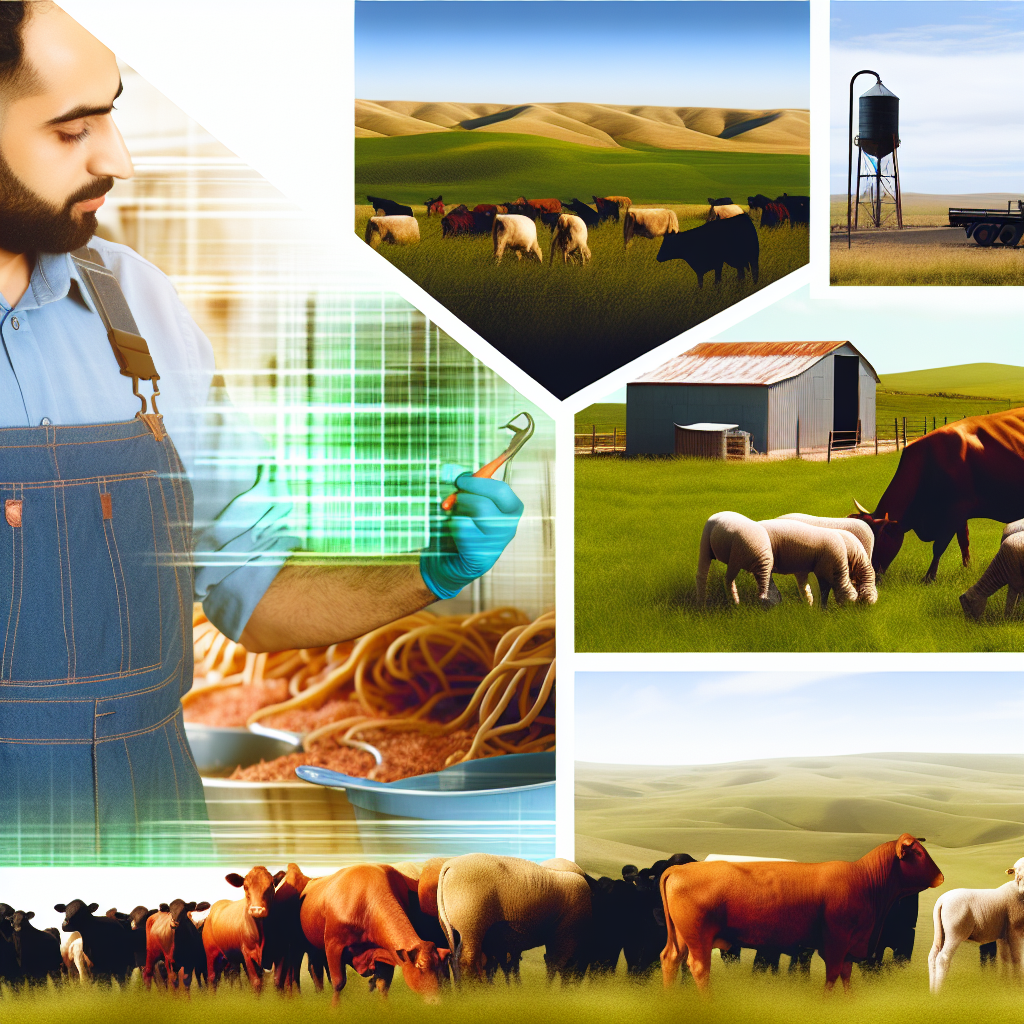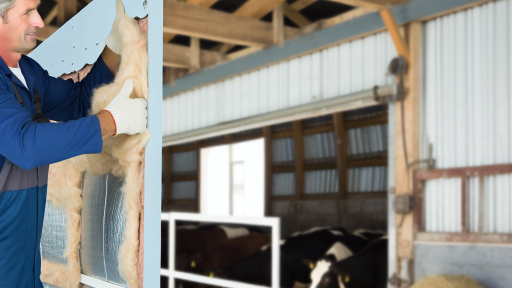Understanding Genetic Principles in Livestock Breeding
Fundamentals of Genetics
Genetics forms the basis of livestock breeding strategies.
It involves the study of genes and heredity.
Understanding these principles helps farmers improve stock quality.
Additionally, genetic knowledge supports the selection of desired traits.
Key Genetic Concepts
Several fundamental concepts are essential in livestock breeding.
- The gene is the basic unit of heredity.
- Genotype refers to the genetic composition of an organism.
- Phenotype is the observable characteristics of an organism.
- Homozygous individuals have identical alleles for a trait.
- Heterozygous individuals have different alleles for a trait.
Selection Methods
Farmers utilize various selection methods to improve livestock.
These methods include natural selection and artificial selection.
Natural selection promotes the survival of the fittest individuals.
Artificial selection involves human intervention in breeding.
This method aims to enhance specific traits in the population.
Understanding Inbreeding and Crossbreeding
Inbreeding occurs when closely related animals are bred together.
This approach can lead to desirable traits but also has risks.
Crossbreeding mixes different breeds to introduce genetic diversity.
It can enhance productivity and disease resistance.
Farmers must weigh the benefits and challenges of each method.
Transform Your Agribusiness
Unlock your farm's potential with expert advice tailored to your needs. Get actionable steps that drive real results.
Get StartedThe Role of Technology in Animal Breeding
Technology plays a vital role in modern livestock breeding.
DNA testing helps farmers make informed breeding decisions.
Artificial insemination allows for wider genetic reach.
Additionally, genomic selection accelerates genetic improvements.
These advancements lead to healthier and more productive herds.
The Importance of Selecting the Right Breeding Stock
Understanding Genetic Traits
Genetic traits play a critical role in animal performance.
Farmers must understand which traits enhance productivity.
These traits include growth rate, feed efficiency, and disease resistance.
Higher productivity leads to increased profitability for the farm.
Evaluating Breeding Stock
Proper evaluation of breeding stock is essential.
Farmers should look for animals with superior characteristics.
These characteristics should meet specific production goals.
Utilizing performance records can assist in this evaluation.
Importance of Health Status
Health status significantly impacts breeding success.
Choosing healthy animals reduces the risk of disease transmission.
This strategy ensures a strong and viable offspring population.
Regular veterinary check-ups help maintain overall health.
Consideration of Genetic Diversity
Maintaining genetic diversity is crucial for herd viability.
Genetic diversity helps to improve resilience against diseases.
It also prevents inbreeding, which can lead to health issues.
Farmers should avoid using closely related breeding stock.
Selecting Based on Production Goals
Each livestock operation has unique production goals.
Farmers must align their breeding choices with these goals.
For example, meat producers may prioritize growth traits.
Showcase Your Farming Business
Publish your professional farming services profile on our blog for a one-time fee of $200 and reach a dedicated audience of farmers and agribusiness owners.
Publish Your ProfileConversely, dairy farmers may focus on milk yield and quality.
Utilizing Technology in Breeding Decisions
Modern technology aids in making informed breeding decisions.
Tools such as genetic testing and performance tracking are beneficial.
These technologies provide insights into traits and potential outcomes.
Farmers can optimize their breeding programs effectively.
Utilizing Performance Data for Breeding Decisions
Importance of Performance Data
Performance data plays a critical role in breeding decisions.
It provides valuable insights into the traits of livestock.
Farmers can make informed choices when selecting breeding stock.
Additionally, tracking cattle performance helps improve herd quality.
Gathering Performance Data
Collecting accurate data is essential for effective breeding strategies.
Farmers should document key metrics, including weight, growth rate, and reproduction rates.
Moreover, consider using digital tools for data management.
These tools can streamline the data collection process.
Analyzing Performance Data
Data analysis helps identify trends and patterns in livestock performance.
Farmers can use this information to select the best breeding candidates.
Furthermore, analyzing data is beneficial for setting breeding goals.
Consider using statistical software for complex analyses.
Implementing Breeding Decisions
Implement the decisions based on the analyzed performance data.
Communicate the changes clearly to all team members on the farm.
This ensures everyone is aligned with the breeding strategy.
Regularly monitor the impact of these decisions over time.
Adjusting Strategies Based on Data
Breeding strategies should be flexible and adaptable.
As new data comes in, reassess your breeding choices.
Adjustments can lead to improved herd performance and profitability.
Stay informed about advancements in breeding technologies as well.
Case Studies and Success Stories
Reviewing real-life examples can enhance understanding.
Successful farmers share how data transformed their breeding practices.
For instance, Amy’s Dairy Farm increased milk production by 20% using data analysis.
Such stories provide motivation for farmers to utilize performance data.
Gain More Insights: Feeding Strategies for Exotic Livestock
Incorporating Artificial Insemination Techniques
Understanding the Basics of Artificial Insemination
Artificial insemination (AI) is a vital breeding method for livestock farmers.
This technique involves the manual injection of semen into the reproductive tract of females.
Farmers can access superior genetic material through AI.
Consequently, it enhances breeding efficiency and productivity.
Benefits of Artificial Insemination
One significant advantage is improved herd genetics.
AI allows for the use of genetic material from high-quality sires.
Moreover, it reduces the risk of disease transmission.
Farmers can also manage breeding schedules more effectively.
Additionally, AI can lead to lower costs compared to natural breeding options.
Choosing the Right Semen Source
Selecting a reputable semen supplier is crucial for success.
Showcase Your Farming Business
Publish your professional farming services profile on our blog for a one-time fee of $200 and reach a dedicated audience of farmers and agribusiness owners.
Publish Your ProfileFarmers should ensure the provider conducts thorough health assessments.
They must also verify the genetic quality of the semen offered.
Furthermore, farmers should consider local climate adaptability of the genetics.
Training and Skill Development
Proper training in AI techniques is essential for farmers.
Understanding reproductive anatomy and physiology aids in successful insemination.
Farmers can attend workshops and courses offered by agricultural extension services.
Experienced professionals or veterinarians can provide hands-on training.
Timing and Technique
Proper timing enhances the success of artificial insemination.
Farmers should monitor estrus cycles carefully.
They can utilize hormonal treatments to synchronize breeding times.
Applying correct insemination techniques ensures better semen deposition.
Post-Insemination Care
Post-insemination care plays a critical role in the process.
Farmers must provide a stress-free environment for the animals.
Furthermore, monitoring the females for signs of pregnancy is essential.
Practicing good nutrition and health management supports successful outcomes.
Evaluating Success Rates
Regularly evaluating AI success rates helps farmers improve practices.
Keeping records of every insemination can provide valuable insights.
Farmers should analyze pregnancy rates and calf quality closely.
Adjusting techniques based on evaluations can lead to continuous improvement.
See Related Content: Optimal Layouts For Livestock Housing Units
Strategies for Crossbreeding and Hybrid Vigor
Understanding Crossbreeding
Crossbreeding involves mating animals from different breeds.
This method maximizes hybrid vigor in offspring.
Hybrid vigor, or heterosis, enhances traits like growth rate and fertility.
Farmers should carefully select breeds that complement each other.
Combining strengths can lead to superior livestock.
Choosing the Right Breeds
Selecting appropriate breeds is crucial for success.
Consider breeds with desirable traits for your farming goals.
For instance, pairing a high-yield breed with a disease-resistant breed works well.
Evaluate the environmental conditions on your farm.
Different breeds thrive in specific climates and terrains.
Implementing a Crossbreeding Program
Start by defining the goals of your crossbreeding program.
Create a detailed plan outlining the desired outcomes.
Track each generation for performance and traits.
Adjust your strategy based on the results you observe.
This iterative process facilitates continuous improvement.
Maintaining Consistency
Consistency is key to producing high-quality livestock.
Establish a breeding schedule to ensure regular mating cycles.
Keep detailed records of breeding pairs and their offspring.
Monitor the genetic diversity within your flock or herd.
This practice prevents inbreeding and promotes a healthy gene pool.
Showcase Your Farming Business
Publish your professional farming services profile on our blog for a one-time fee of $200 and reach a dedicated audience of farmers and agribusiness owners.
Publish Your ProfileManaging Health and Nutrition
Healthy livestock are more likely to thrive from crossbreeding.
Prioritize proper nutrition to support growth and reproduction.
Incorporate vitamins and minerals into their feed.
Regular health checks can prevent diseases that affect performance.
Consider vaccinations and preventive treatments as necessary.
Evaluating Results
After implementing your crossbreeding strategy, evaluate the outcomes.
Analyze growth rates, health indicators, and reproductive performance.
Compare the results to your initial breeding goals.
If goals are not met, identify and adjust your tactics.
Continuous evaluation guides future breeding decisions.
Learn More: Preventing Diseases in Exotic Livestock

Managing Breeding Cycles for Optimal Production
Understanding Breeding Cycles
Breeding cycles determine the timing of reproduction in livestock.
Knowing these cycles helps farmers optimize breeding schedules.
Each species has specific reproductive patterns.
For example, cattle typically have a 21-day estrous cycle.
On the other hand, sheep have a shorter cycle of 16 to 17 days.
Understanding these differences supports better herd management.
Monitoring Estrous Behavior
Monitoring estrous behavior is crucial for effective breeding.
Farmers can observe physical signs of heat in females.
Common signs include restlessness and heightened vocalization.
Use technology like heat detection systems for more accuracy.
These systems enhance the likelihood of successful breeding opportunities.
Timing of Breeding
Timing plays a significant role in breeding success.
For best results, breed the female at the peak of estrus.
This period usually lasts 12 to 24 hours.
Coordinating with a veterinarian can improve timing precision.
Artificial insemination can also ensure optimal timing.
Utilizing Genetic Evaluation
Genetic evaluation helps farmers select superior breeding stock.
Consider traits like growth rate and disease resistance.
Tools such as DNA testing facilitate informed decisions.
Focus on breeding goals that match market demands.
This strategy boosts profitability for livestock farmers.
Implementing Health Management Practices
Health management directly affects breeding outcomes.
Regular veterinary care keeps livestock healthy and fertile.
Vaccinations prevent diseases that could impair reproduction.
Nutrition plays a vital role in maintaining breeding health.
Provide balanced diets to support overall well-being.
Establishing a Record-Keeping System
Effective record-keeping systems are essential for tracking data.
Document breeding dates, health statuses, and offspring details.
This data helps identify successful pairing and breeding patterns.
Showcase Your Farming Business
Publish your professional farming services profile on our blog for a one-time fee of $200 and reach a dedicated audience of farmers and agribusiness owners.
Publish Your ProfileRegular reviews can inform future breeding decisions.
Utilize software tools for easier management of this information.
You Might Also Like: Essential Features Of Modern Livestock Housing
Health and Nutrition Considerations in Breeding Programs
The Importance of Nutrition
Nutrition plays a critical role in successful breeding programs.
It directly influences the reproductive success of livestock.
Poor nutrition can lead to lower conception rates.
Additionally, it affects birth weights and overall animal health.
A balanced diet enhances genetic potential in herds.
Key Nutritional Components
Livestock require specific nutrients for optimal health.
These nutrients include proteins, vitamins, and minerals.
- Proteins support tissue growth and repair.
- Vitamins A and E are vital for reproductive health.
- Minerals like calcium and phosphorus strengthen bones.
Incorporating these into daily rations is essential.
Monitoring Health Indicators
Monitoring livestock health is crucial to breeding success.
Regular veterinary check-ups ensure early detection of issues.
Body condition scoring helps assess nutritional status.
Healthy animals have better fertility rates.
Furthermore, tracking growth rates aids in evaluating nutrition programs.
Preventative Health Measures
Implementing preventative health measures significantly impacts breeding outcomes.
Vaccination programs protect against common diseases.
Parasite control is vital for maintaining livestock health.
Establishing a biosecurity plan reduces disease transmission.
Record Keeping and Evaluation
Accurate record-keeping enhances breeding program effectiveness.
Records should include health checks, diet changes, and breeding dates.
Evaluating this data identifies successful strategies and areas for improvement.
Regular reviews help in adapting nutrition and health plans.
Evaluating and Implementing Sustainable Breeding Practices
Importance of Sustainable Breeding
Sustainable breeding practices enhance livestock resilience.
They also improve productivity while conserving resources.
Farmers can reduce environmental impacts through these methods.
Assessing Current Breeding Strategies
First, evaluate the effectiveness of existing breeding programs.
Gather data on herd performance and health indicators.
Identify areas needing improvement or adjustment.
Engage with experienced breeders for insights and advice.
Consider incorporating advanced technologies for assessment.
Setting Breeding Goals
Establish clear, achievable breeding goals for your farm.
Focus on traits that enhance sustainability and productivity.
Examples include disease resistance, growth rate, and reproductive efficiency.
Align your objectives with market demands and consumer preferences.
Choosing Suitable Breeding Stock
Select breeding stock based on performance and genetic potential.
Use pedigree and performance data to inform choices.
Consider the adaptability of breeds to local conditions.
Always prioritize health and vitality in your selections.
Showcase Your Farming Business
Publish your professional farming services profile on our blog for a one-time fee of $200 and reach a dedicated audience of farmers and agribusiness owners.
Publish Your ProfileImplementing Genetic Diversity
Incorporate genetic diversity into your breeding programs.
Diverse genetics enhance resilience against diseases and environmental changes.
Utilize crossbreeding strategies to achieve desired traits.
Monitor the impact of genetic diversity on herd performance over time.
Monitoring and Evaluating Breeding Outcomes
Regularly track the performance of offspring to assess breeding success.
Document health, growth rates, and reproductive success in records.
Adjust breeding strategies based on performance data and outcomes.
Engage with professionals for feedback and new ideas.
Investing in Education and Training
Stay informed about the latest developments in breeding practices.
Invest in training programs for yourself and your staff.
Participate in workshops, webinars, and conferences focused on livestock breeding.
Network with other livestock farmers to share experiences and knowledge.
Additional Resources
Heritage Livestock Breeds – Why are they important? – The Livestock …




